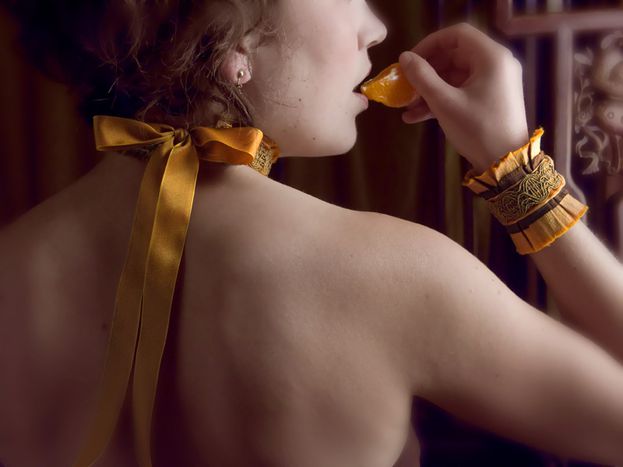
European literary sex guide: five lessons from the classics
Published on
In mid-September, Russia’s children’s ombudsman Pavel Astakhov argued that in order to protect innocent children from corruption, young Russians should look to the classics for sex education, to learn all that they need to about love and relationships, chastity and family values. From sadist France to Gothic Ireland, classic European literature has dubious pious pointers
Russia: Anna Karenina, by Leo Tolstoy (1877)
'I think... if it is true that there are as many minds as there are heads, then there are as many kinds of love as there are hearts'
 In Tolstoy’s Anna Karenina, love is laced with sadness, lust shadowed with forboding, and sex proves to be the characters’ undoing. The beautiful aristocrat Anna Karenina, bored and unsatisfied by her passionless marriage with a government minister, finds love in the arms of the debonair military officer Count Vronsky. Her marriage unravels, the affair becomes public knowledge and Anna is shunned by society and her friends. Her relationship with Vronsky begins to crumble, aided by the hypocrisy of a society which allows him to continue with life as normal while she is left ostracised and alone. Jealous, paranoid and possessive, Anna fears that Vronsky will leave her, and after one particularly vitriolic argument she throws herself into the path of an oncoming train.
In Tolstoy’s Anna Karenina, love is laced with sadness, lust shadowed with forboding, and sex proves to be the characters’ undoing. The beautiful aristocrat Anna Karenina, bored and unsatisfied by her passionless marriage with a government minister, finds love in the arms of the debonair military officer Count Vronsky. Her marriage unravels, the affair becomes public knowledge and Anna is shunned by society and her friends. Her relationship with Vronsky begins to crumble, aided by the hypocrisy of a society which allows him to continue with life as normal while she is left ostracised and alone. Jealous, paranoid and possessive, Anna fears that Vronsky will leave her, and after one particularly vitriolic argument she throws herself into the path of an oncoming train.
Lesson no 1: Heartbreak, despair and suicide.
ITALY: The Decameron, by Giovanni Boccaccio (1353)
'A kissed mouth doesn’t lose its fortune, on the contrary it renews itself just as the moon does'
Renaissance writer Giovanni Boccaccio held some fairly unconventional ideas for his time - including the outlandish notion that women were in fact human - and the even more staggering idea that they might in fact be equal to men in some respects. In Decamerone ('The Decameron'), a text commonly considered to be a precursor to Geoffrey Chaucer's The Canterbury Tales, Boccaccio gathers his ten young characters in an isolated villa in the countryside and has them tell tales of life, sin, love and lust.
 There’s a lot of sex in these stories: from a convent of nuns who hire a gardener to fulfil all their sexual needs, to a hermit who deflowers a maiden only to discover that her sexual appetite far surpasses his own, to extramarital affairs and horseplay aplenty. Boccaccio avoids moralising on the topic, deeming the laws of nature to be far more compelling than mere social morality.
There’s a lot of sex in these stories: from a convent of nuns who hire a gardener to fulfil all their sexual needs, to a hermit who deflowers a maiden only to discover that her sexual appetite far surpasses his own, to extramarital affairs and horseplay aplenty. Boccaccio avoids moralising on the topic, deeming the laws of nature to be far more compelling than mere social morality.
Lesson no 2: Love and sex are irresistible forces of nature.
Ireland: Dracula, by Bram Stoker (1897)
'There was a deliberate voluptuousness that was both thrilling and repulsive, and as she arched her neck she actually licked her lips like an animal… Lower and lower went her head. I closed my eyes in a languorous ecstasy and waited'
This nineteenth century epistolary novel is all about sex. Long before Twilight had girls swooning over vampires, Count Dracula was seducing women into opening their boudoirs to him. And he didn’t glitter. Instead, the bloodthirsty aristo corrupts the pure English girls through penetration, through which method he becomes in a sense both their father and their sexual partner.
 It gets worse. The madonna/whore dichotomy has rarely been so creepy, in a text exemplifying the Victorian terror of female sexuality. Dear sweet Lucy is transformed by Count Dracula’s bite into a bloodsucking sexual predator and her previous suitors, appalled at the desire that undead Lucy awakens in them, proceed to join together to hammer a stake through her heart. A big, wooden stake. You don’t need to be Freud for this one.
It gets worse. The madonna/whore dichotomy has rarely been so creepy, in a text exemplifying the Victorian terror of female sexuality. Dear sweet Lucy is transformed by Count Dracula’s bite into a bloodsucking sexual predator and her previous suitors, appalled at the desire that undead Lucy awakens in them, proceed to join together to hammer a stake through her heart. A big, wooden stake. You don’t need to be Freud for this one.
Lesson no 3: Necrophilia, incest, and group sex.
SPAIN: Don Quixote, by Miguel de Cervantes (1605)
'There were no embraces, because where there is great love there is often little display of it'
Don Quixote is essentially one great spoof of the medieval romance genre. The mentally unstable protagonist, under the influence of too many books of chivalry, renames himself and his horse, and sets out on a quest. His grand passion is an imaginary one, the middle-aged Don designates a nearby farm girl Dulcinea del Toboso and defends her honour at every opportunity, tilting with windmills and accosting strangers in the name of chivalry and of his lady love. When, in the end, Quixote recovers his sanity, he bequeaths his fortune to his niece on the condition that she should not marry a man who reads books of chivalry. The moral of the story is that fantasy does not equal reality. And you shouldn’t believe everything that you read in books.
Lesson no 4: Be still, my beating heart... romance is chaste when it is imaginary.
FRANCE: The Philosophy of the Bedroom, by Marquis de Sade (1795)
'What does one want when one is engaged in the sexual act? That everything around you give you its utter attention, think only of you, care only for you... every man wants to be a tyrant when he fornicates'
Think France, think romance? Think again. The Marquis de Sade, the libertine aristocrat whose behaviour gave the world the word ‘sadism’, wrote erotic treatises in which he glorified torture, rape and above all else the pursuit of sexual pleasure. In La Philosophie dans le boudoir ('The philosophy of the bedroom') the virginal Eugénie is sent by her father to receive a sexual education at the hands of Madame Saint-Ange and her compatriots.
 The book broke every sexual taboo of the time, and some they hadn’t even thought of. Morality is slammed as a mere social construct as the characters in the book corrupt and are corrupted in every sense.
The book broke every sexual taboo of the time, and some they hadn’t even thought of. Morality is slammed as a mere social construct as the characters in the book corrupt and are corrupted in every sense.
Lesson no 5: Graphic heterosexual and homosexual encounters, rape, torture, violence and incest.



